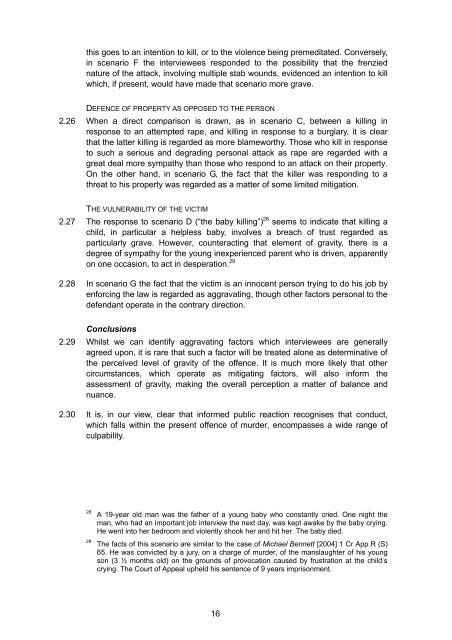lc290 Partial Defences to Murder report - Law Commission
lc290 Partial Defences to Murder report - Law Commission
lc290 Partial Defences to Murder report - Law Commission
Create successful ePaper yourself
Turn your PDF publications into a flip-book with our unique Google optimized e-Paper software.
this goes <strong>to</strong> an intention <strong>to</strong> kill, or <strong>to</strong> the violence being premeditated. Conversely,<br />
in scenario F the interviewees responded <strong>to</strong> the possibility that the frenzied<br />
nature of the attack, involving multiple stab wounds, evidenced an intention <strong>to</strong> kill<br />
which, if present, would have made that scenario more grave.<br />
DEFENCE OF PROPERTY AS OPPOSED TO THE PERSON<br />
2.26 When a direct comparison is drawn, as in scenario C, between a killing in<br />
response <strong>to</strong> an attempted rape, and killing in response <strong>to</strong> a burglary, it is clear<br />
that the latter killing is regarded as more blameworthy. Those who kill in response<br />
<strong>to</strong> such a serious and degrading personal attack as rape are regarded with a<br />
great deal more sympathy than those who respond <strong>to</strong> an attack on their property.<br />
On the other hand, in scenario G, the fact that the killer was responding <strong>to</strong> a<br />
threat <strong>to</strong> his property was regarded as a matter of some limited mitigation.<br />
THE VULNERABILITY OF THE VICTIM<br />
2.27 The response <strong>to</strong> scenario D (“the baby killing”) 28 seems <strong>to</strong> indicate that killing a<br />
child, in particular a helpless baby, involves a breach of trust regarded as<br />
particularly grave. However, counteracting that element of gravity, there is a<br />
degree of sympathy for the young inexperienced parent who is driven, apparently<br />
on one occasion, <strong>to</strong> act in desperation. 29<br />
2.28 In scenario G the fact that the victim is an innocent person trying <strong>to</strong> do his job by<br />
enforcing the law is regarded as aggravating, though other fac<strong>to</strong>rs personal <strong>to</strong> the<br />
defendant operate in the contrary direction.<br />
Conclusions<br />
2.29 Whilst we can identify aggravating fac<strong>to</strong>rs which interviewees are generally<br />
agreed upon, it is rare that such a fac<strong>to</strong>r will be treated alone as determinative of<br />
the perceived level of gravity of the offence. It is much more likely that other<br />
circumstances, which operate as mitigating fac<strong>to</strong>rs, will also inform the<br />
assessment of gravity, making the overall perception a matter of balance and<br />
nuance.<br />
2.30 It is, in our view, clear that informed public reaction recognises that conduct,<br />
which falls within the present offence of murder, encompasses a wide range of<br />
culpability.<br />
28 A 19-year old man was the father of a young baby who constantly cried. One night the<br />
man, who had an important job interview the next day, was kept awake by the baby crying.<br />
He went in<strong>to</strong> her bedroom and violently shook her and hit her. The baby died.<br />
29 The facts of this scenario are similar <strong>to</strong> the case of Michael Bennett [2004] 1 Cr App R (S)<br />
65. He was convicted by a jury, on a charge of murder, of the manslaughter of his young<br />
son (3 ½ months old) on the grounds of provocation caused by frustration at the child’s<br />
crying. The Court of Appeal upheld his sentence of 9 years imprisonment.<br />
16

















